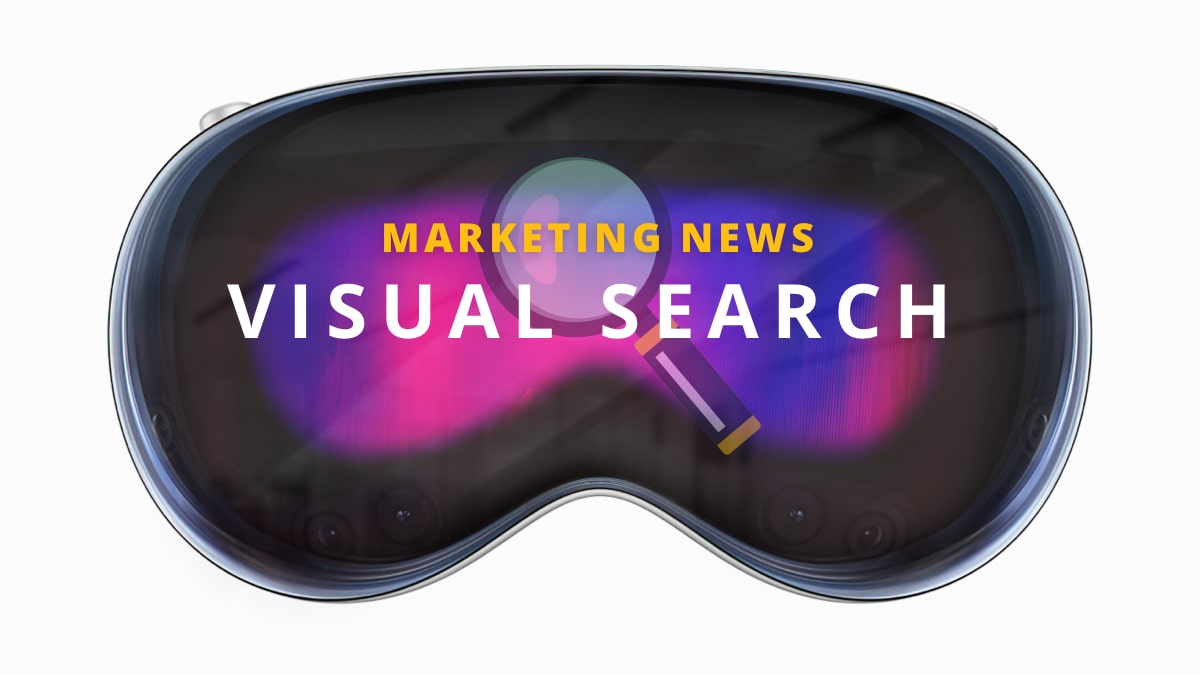
The world of technology is abuzz with speculation surrounding Apple’s Vision Pro, an augmented reality (AR) and spatial computing headset poised to revolutionize how we interact with information and engage with brands.
While its features are still being explored, the potential impact of Vision Pro on visual search and marketing will be undeniable. Let’s explore some of the exciting possibilities and challenges that this innovative technology might present.
Reimagining Visual Search and Spacial Computing:
Apple’s Vision Pro headset has a feature called “Visual Search” that uses the power of visionOS to let users interact with the world in new, and novel ways.
Vision Pro’s capabilities promise to transform how we search for and access information visually. Imagine effortlessly identifying objects with a mere glance, instantly translating text on a page, signs or menus, or accessing real-time reviews and historical context about landmarks simply by pointing your headset. Advanced sensors and processing power would enable seamless object recognition, blurring the lines between the physical and digital worlds.
Location-based search takes a leap forward with Vision Pro too. Imagine exploring a new city and receiving relevant information about nearby restaurants, shops, or historical sites overlaid onto your actual surroundings. This contextual understanding could revolutionize travel experiences and local business discovery.
But the most transformative aspect lies in mixed reality (MR) integration. Vision Pro could overlay virtual objects onto the real world, allowing for immersive experiences like trying on clothes virtually, visualizing furniture in your home before purchase, or even exploring educational simulations. This immersive approach has the potential to redefine product visualization, enhance learning, and fundamentally change how we interact with digital information.
For marketers, spatial computing can also be used for things like visualizing complex data sets in three-dimensional space, providing marketers with new insights and opportunities for analysis. For example, marketers could use spatial computing to visualize customer demographics or sales trends in a way that is more intuitive and actionable than traditional charts or graphs.
Marketing in the AR and Visual Computing Age:
For marketers, Vision Pro opens a door to a new era of engagement. Imagine creating interactive mixed-reality experiences where customers can virtually explore products, interact with features, and even personalize their choices. This shift from static images and videos to dynamic, interactive experiences could revolutionize product marketing and lead to a deeper understanding of customer preferences.
Personalized product visualization is an exciting prospect. Imagine virtually trying on clothes that adjust to your body size or seeing furniture seamlessly placed in your home environment. This immersive approach could empower customers to make informed decisions and potentially reduce product returns.
However, with great power comes great responsibility. Data privacy concerns are paramount. Balancing engaging experiences with user privacy will be crucial for brands navigating this new landscape. Transparency in data collection practices and user control over their information will be key to building trust and ensuring ethical adoption of AR technology.
The Competitive Landscape:
The arrival of Vision Pro could significantly impact the existing search landscape. Google Lens took a stab at visual search and the Vision Pro offers superior features and seamless integration within Apple’s ecosystem. However, collaboration and standardization between tech giants could benefit both platforms and users in the long run. Imagine a future where AR and AI (Artificial intelligence) experiences are accessible across devices and platforms, fostering innovation and wider adoption.
Other players in the AR/VR space, like Microsoft and Meta, are also currently vying for dominance and it’s likely going to be an uphill battle for them. Each company brings unique strengths and approaches to the table, creating a dynamic and competitive landscape that will ultimately benefit users with diverse options and accelerated innovation.
The future of Vision Pro is exciting. The potential to reshape visual search and marketing is undeniable. This short glimpse into the current and future possibilities highlights the need for businesses and individuals to explore, adapt, and embrace innovation.
The Future Beckons:
By understanding the possibilities and challenges presented by this technology, we can prepare for a future where the lines between the physical and digital worlds become increasingly blurred, and information is accessed and interacted with in entirely new ways.
As more details about Vision Pro emerge, we will dig deeper into specific applications, ethical considerations, and the broader societal implications of this transformative technology in the future. The future of visual search and marketing is waiting to be written, and Apple’s Vision Pro might just be the first chapter in a captivating new story.
Most Popular Articles

Seeing Favicons in Your Google Search Results? Here’s Why…
Have you noticed anything different in your Google Search results lately? Google added tiny favicon icons to its organic search results in January. It was…

Business Growth and Digital Marketing News & Tips 11-17-24
Are you encouraging and rewarding innovation? Lee Cockerell is the former Executive Vice President of Operations at Walt Disney World. A lover of traditional red…

Business Growth and Digital Marketing News & Tips 11-27-24
A culture of gratitude "Feeling gratitude and not expressing it is like wrapping a present and not giving it." – William Arthur Ward Beyond being…








